

A “Thank you for signing up” email starts you off on the right foot with new subscribers and customers. But, by adding a little extra to your first message you can gain much more than this. Learn the tactics that work with this list of the best welcome email examples.
That moment, when you reach out to someone — only to be ignored.
It’s never a good feeling.
And the same applies to your email marketing. Whether it’s subscribing to your email list, signing up for your services, or making a first purchase, your response to new contacts can make or break the relationship.
The examples below are full of best practices and ideas to help you create a welcome email template that’ll engage subscribers from the start.
Table of Contents
Why Your Brand Needs a Welcome Email
First impressions count. And if you don’t bother with a welcome email, you’re missing out on an opportunity to make a good one.
While there are lots of different ways your welcome message can achieve this, the basic concept remains the same.
What is a welcome email?
A welcome email is an automated message to new subscribers or customers acknowledging them and introducing what you have to offer. They’re often part of a welcome email series that aims to get this audience to further engage with your business.
Take note of the last part of that definition – welcome emails are more than just a way to say thank you for signing up. They’re a chance to show the recipient how they can get the most from your company.
The right introduction for your email subscribers can bring long-term benefits, including:
- Stronger customer relationships: An authentic “thank you for subscribing” will warm people to your brand and build trust.
- More sales and increased customer retention: Presenting your products or services will help boost conversion rates and user engagement.
- Better email engagement rates: If your first email impresses, subscribers will likely take notice of future campaigns too.
If you’re still not convinced, take a look at these welcome email statistics from a report by Experian. It found that, compared to bulk promotional mailings, welcome emails:
- Get four times more opens, with an average open rate of almost 60%
- Generate five times more clicks, with an average click rate of over 14%
- Bring in eight times more revenue per email
How to Write a Welcome Email
Before getting into some examples of different approaches, here’s a basic formula for what to include in your welcome email template:
- Show your appreciation with a genuine “thank you for signing up”.
- Remind recipients what they’ve signed up for and what they can expect.
- Introduce your brand and what you have to offer.
- Provide something of value to get your new audience engaging straight away.
Once you have the content for your welcome message, you’ll need a tool to create your email template and send it automatically after a signup.
Sendinblue’s free email marketing automation software offers an affordable solution with all the essential features. Design emails using the intuitive drag-and-drop editor then set up a welcome journey in just a few clicks using the premade workflow.
Finding a welcome email template
While of course your welcome email design needs to fit your brand, you don’t have to start completely from scratch. The internet is full of free email template resources you can use for your welcome message. Here are a couple of the best ones:
Sendinblue
With a free Sendinblue account you get access to over 60 beautifully designed and fully responsive email templates. The templates are tailored to different sectors and purposes, including for email signups and new customers.
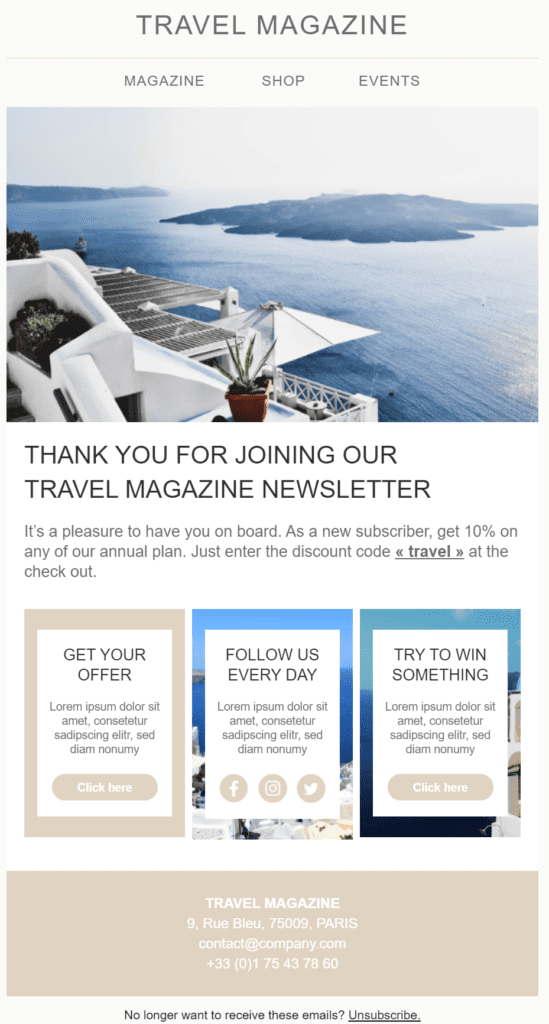
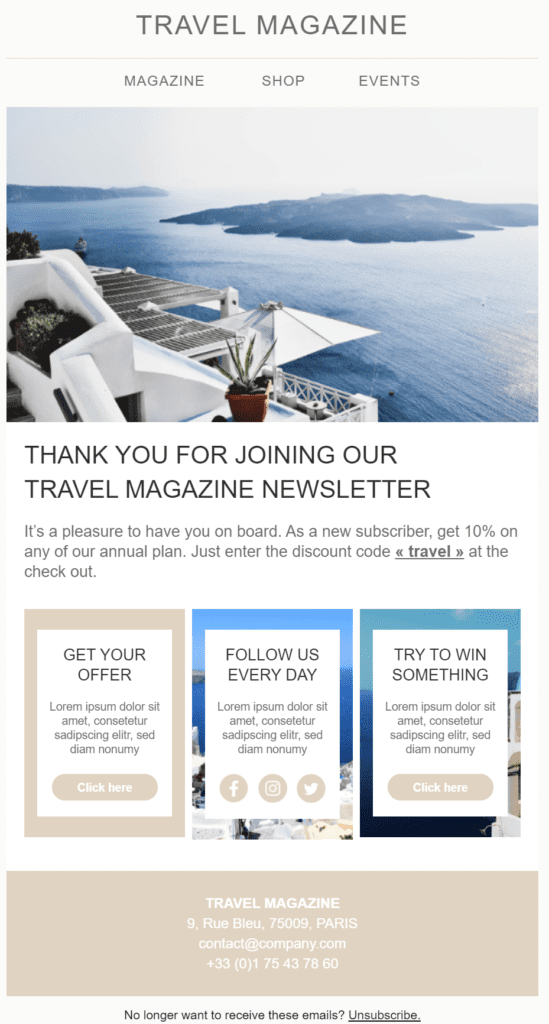
Stripo
Stripo offers over 550 free HTML email templates. What’s great about Stripo is that, without any coding skills, you can jazz up your welcome email design with cool features like CSS-animated buttons, image rollover effects, and other interactive elements.


Unlike Sendinblue, Stripo isn’t an email marketing service so you can’t send your welcome email with it. But if you create your email in Stripo you can then export it to Sendinblue for sending. Stripo allows four exports per month on their free plan.
Now you know how to go about creating a welcome email, you need to choose the right tactics for your audience and business goals. The examples below are full of ideas for how to get the most from your welcome email and ensure your subscribers stick around.
The 9 Best Welcome Email Examples to Inspire Your Strategy
1. The self-introduction
You can’t assume new subscribers and customers already know everything there is about your business. Your welcome email should reinforce your unique selling points to confirm you’re the right choice for them.
Just one word of caution: this doesn’t mean it should be all about you. Instead, emphasize the benefits for your new contacts.
This welcome email example by TravelSupermarket gets the balance right, presenting the perks customers get from using their services while setting expectations for future emails.
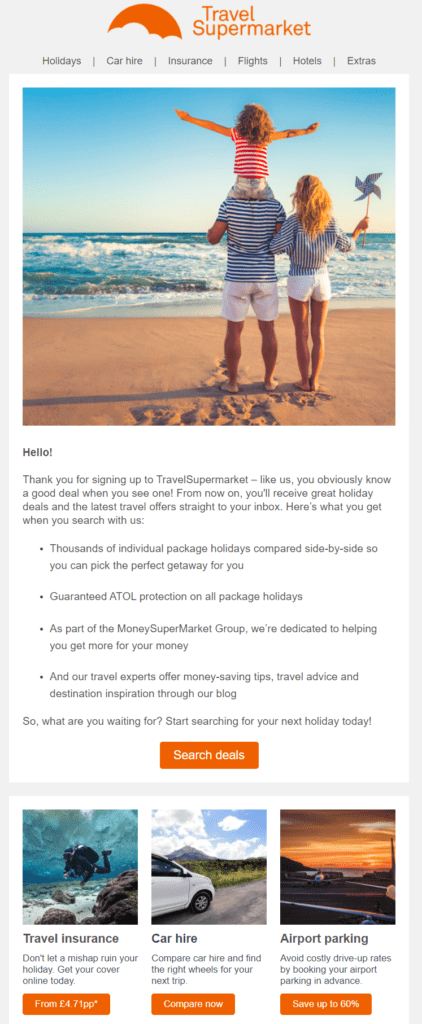

The email keeps it simple by focusing on getting customers to explore their offers rather than overwhelming them with conflicting calls-to-action (CTAs).
TravelSupermarket then uses a Sendinblue automation workflow to follow up their initial “thank you for subscribing” email with more information. This second part of their welcome series offers other ways to engage with their business, like checking out their blog or following them on social media.
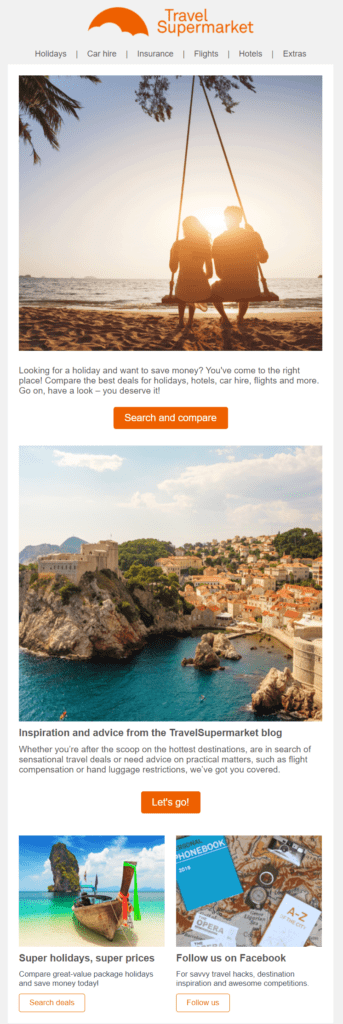
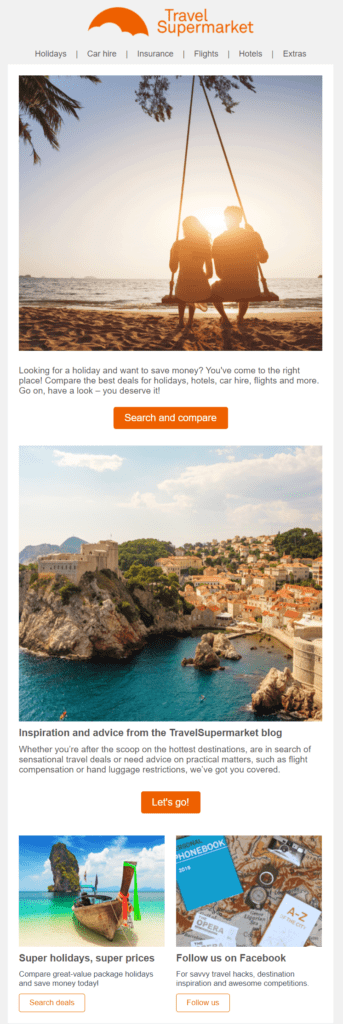
2. The video greeting
Showing rather than telling your new audience what you have to offer can help increase engagement with your welcome email content.
A short video presenting your business brings it to life in a way that’s not possible with text alone. This could be a message from your founder that puts a face to your brand and shares your story, or you could show clips of your product in action.
Alternatively, you can use an animated GIF in your email to get across your brand and its personality, as BarkBox does in their welcome email:


The GIF works hand in hand with the playful email copy to show subscribers what their company’s about.
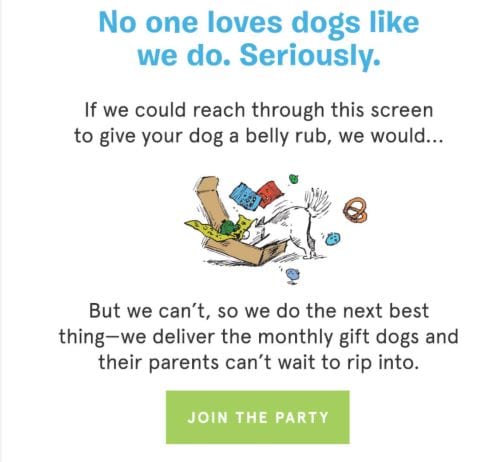

3. The personalized welcome message
To get your introduction just right for each contact, you can adapt the email content based on what you know about them. For example, Zapier tailors their post-registration welcome email to the user’s signup method to make it as valuable as possible.
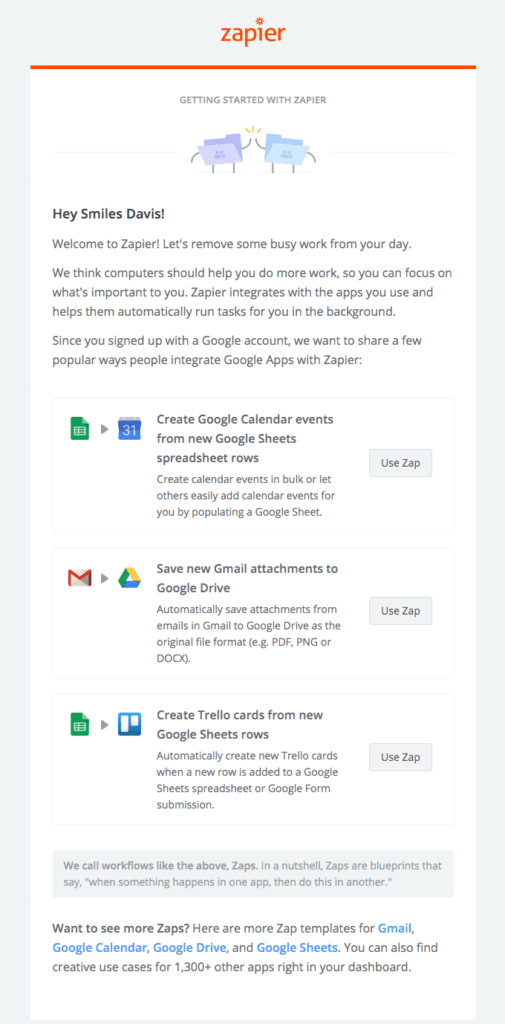
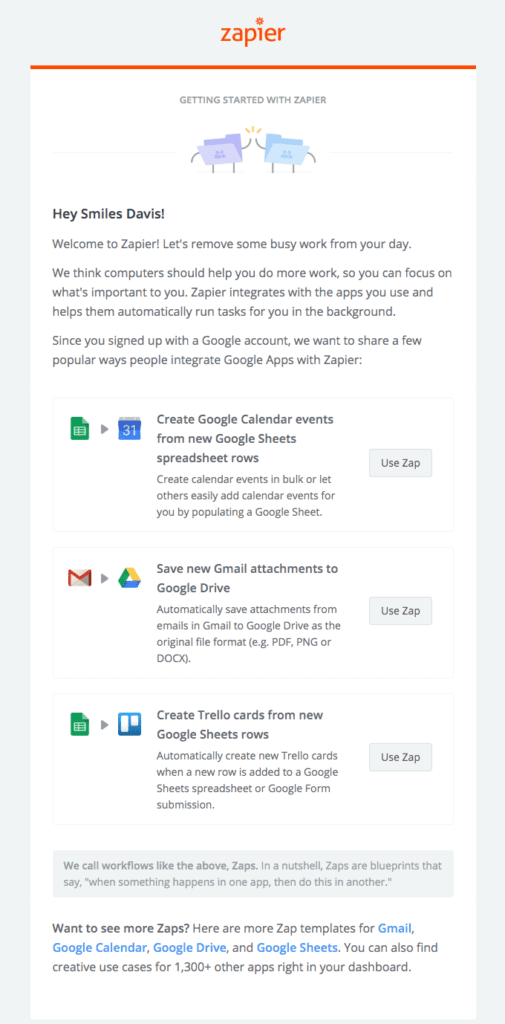
Sendinblue offers personalization tools for sending emails that are unique to the recipient. This can be as simple as adding the contact name to the email body and subject line. Or you can show different content blocks based on criteria such as a subscriber’s interests.
To try this tactic for your welcome email, add questions to your email signup form to learn more about subscribers. Then create content to match different profiles.
4. The getting to know you email
If you prefer to keep your subscription form brief, your welcome email itself can also help you get audience insights.
Use it to find out what subscribers are looking for, like the content they’re interested in or their preferred email frequency. Not only is this valuable information for your strategy but it also shows your audience you’re serious about meeting their needs.
The newsletter welcome message below executes this approach in a simple yet human way:
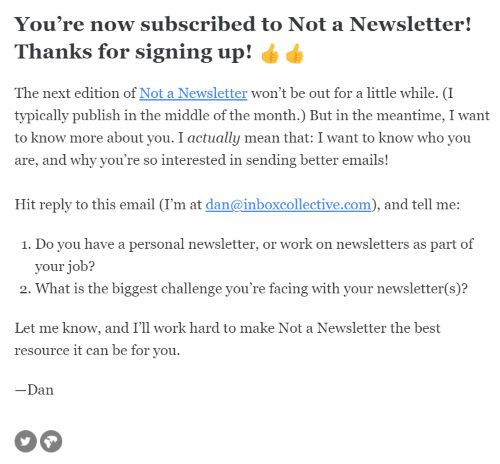

The copy’s conversational tone endears the reader so they’ll be more receptive to the ask. Meanwhile, the email subject line — “Welcome! 👋 I’ve got two questions for you!” — attracts attention with an emoji followed by an intriguing statement.
Rather than asking for direct replies, you could share a link to a profile update form to make collecting responses easier. That way you’ll build a picture of each contact’s interests and preferences to aid with your email list segmentation.
5. The product showcase
For B2C companies aiming to convert would-be customers, a welcome email is your chance to show off your best items so they can’t help but start browsing.
You might choose to shine a spotlight on your flagship product or promote top sellers or new arrivals.
For example, take a look at how Glossier’s welcome email template captures shoppers’ interest with the product imagery in the header. They follow this with a well-crafted brand pitch and a CTA button encouraging the reader to act on the curiosity they’ve instilled.
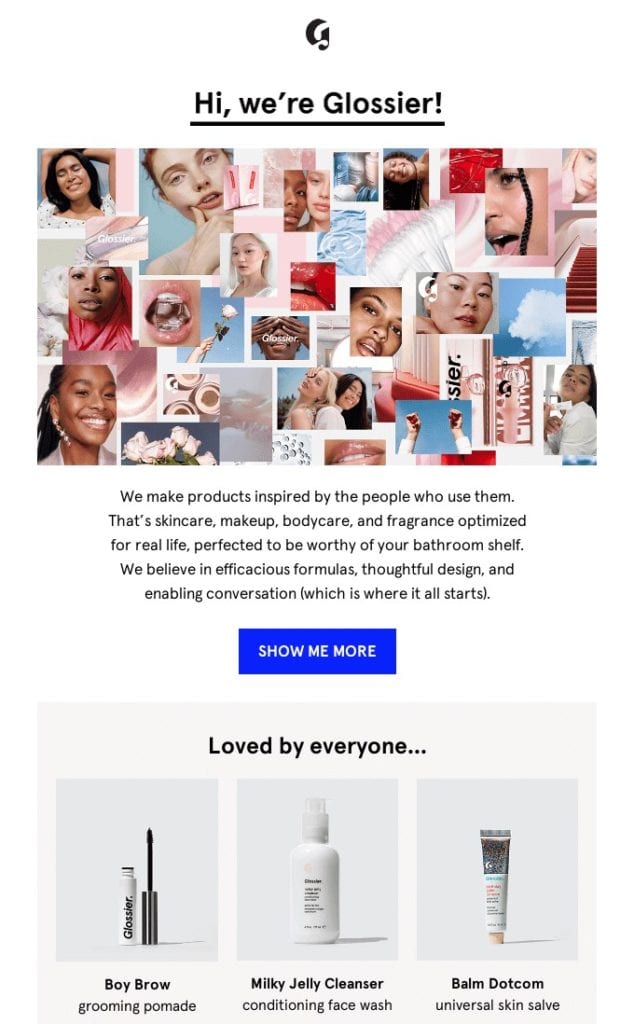
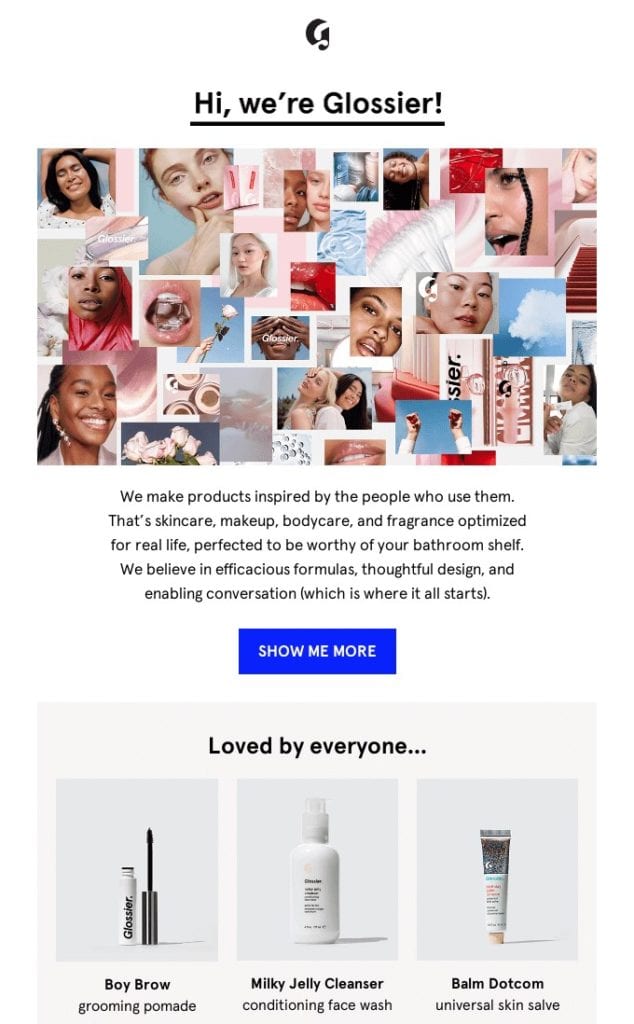
6. The special offer welcome gift
You can further boost sales from your welcome email with incentives like discount codes or free shipping that double up as a thank you for signing up. This tactic works well for ecommerce businesses as the email can direct shoppers straight to their online store to redeem the offer.
For example, skin brand Rootanicals created this welcome email template with Sendinblue to share an exclusive discount with those who sign up on their website.
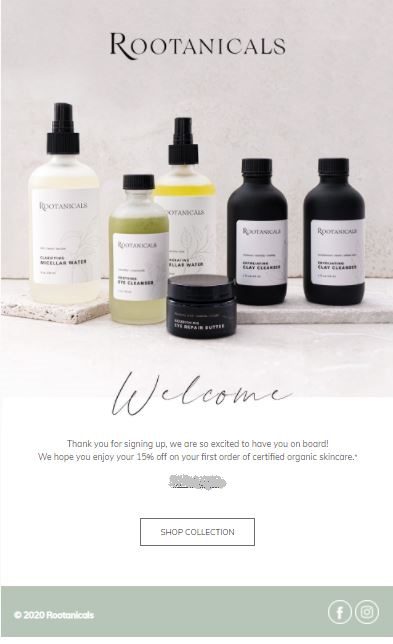

Another trick is to highlight the offer in your welcome email subject line to maximize open rates.
7. The onboarding welcome email
Once a customer has converted, your aim should be to get them up and running with your product as soon as possible. And onboarding emails provide the know-how and motivation they need to do so.
Content should focus on educational resources like tutorials and tips that help new users get started and make the most of your product.
For example, B2B company Workona uses Sendinblue Automation to send a series of welcome emails that guide new customers through their software.
The initial email encourages users to take the first steps in getting set up through clear instructions and a helpful GIF. The CTA button then takes them to the product to try it out. Finally, the customer quote adds a nice touch that shows the benefits they gain.
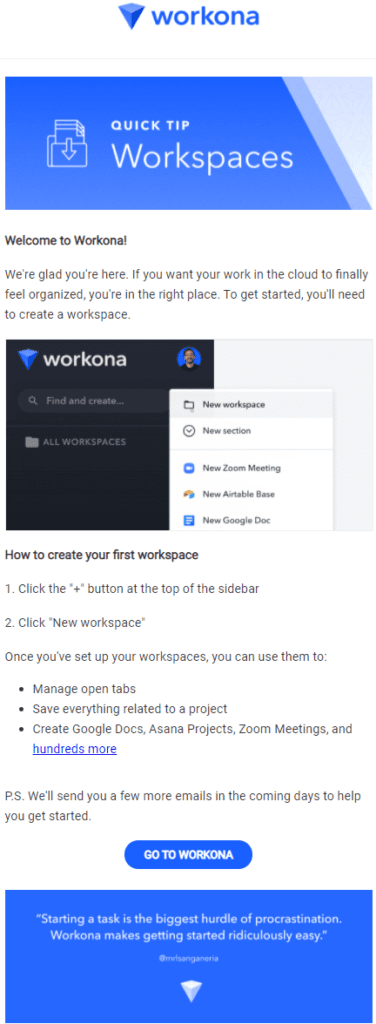
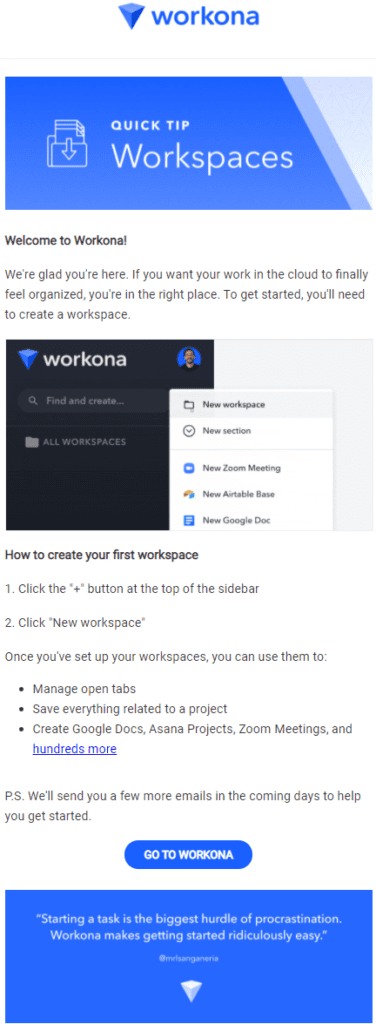
The emails that follow use a similar template to introduce the software’s different features. Each centers around a customer pain point and shows how Workona’s product holds the solution. The subject lines, such as “Tip 1: Solve tab overload” for the email below, highlight the value inside to keep recipients opening their messages.
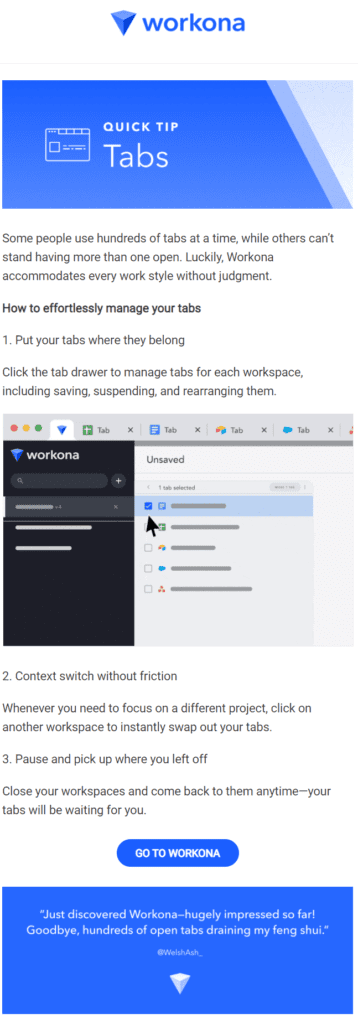

8. The resource delivery email
Lead magnets like cheat sheets, ebooks, or free templates are a great way to get prospective customers onto your email list. But, if your first email contains nothing more than a link to the free resource, you’re missing a trick.
You’ve already managed to draw the contact in with something they want. So now it’s time to guide them down your funnel through to sale.
One tactic is to share your related content, as in the welcome email example below. This helps further build your business’ credibility for prospects by showing your expertise on relevant topics.
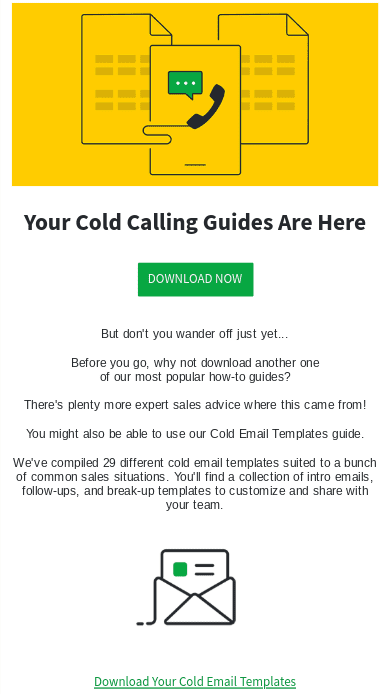
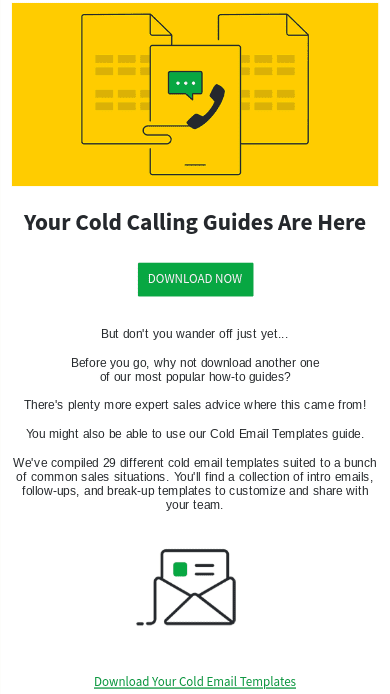
You could also encourage this new audience to discover your product, for example through a free trial or case study. Just be careful not to scare them off by being overly promotional — the key is to offer something valuable that’ll keep them engaged until they’re ready to convert.
9. The customer seal of approval
Another tactic for winning over new contacts without having to toot your own horn is to let your loyal customers do it for you.
Playing on social proof in your welcome message will reassure subscribers they’ve made the right choice with your business and encourage further engagement.
Huckberry’s welcome email is a prime example. It instills confidence from the start by referencing their one million-plus fans.
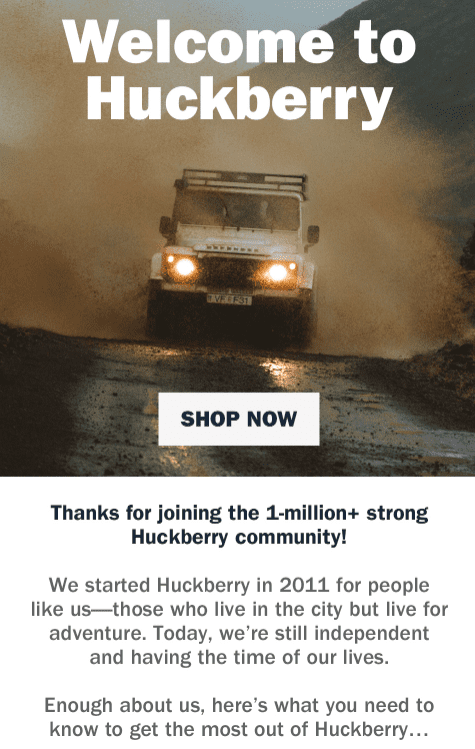
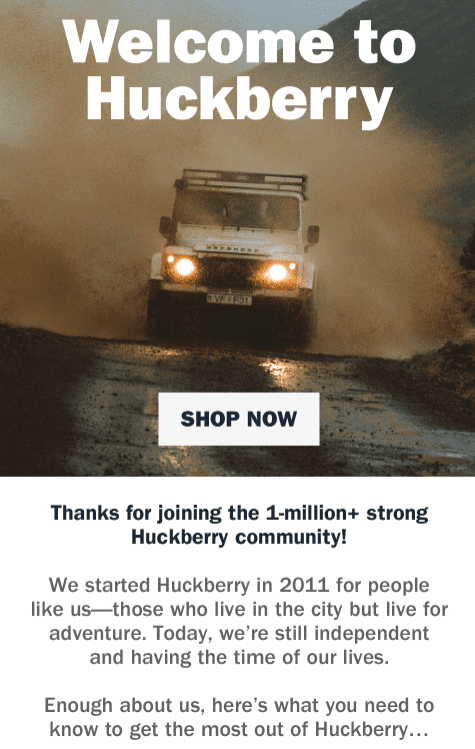
The rest of the email is littered with customer endorsements, from five-star reviews to glowing feedback, that boost the legitimacy of their claims.
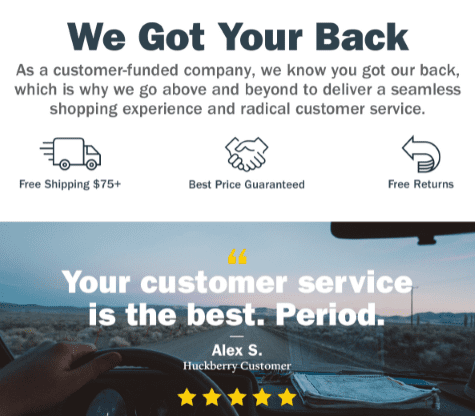
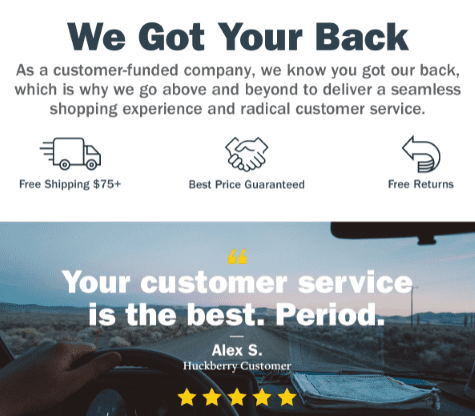
Welcome Email Best Practices to Take Forward for Your Own
Now you’ve seen how it’s done, over to you to try these tactics on your subscribers.
As a recap, here are the key features of a good welcome message:
- An email subject line that gets attention and hints at the value inside
- Customer-focused messaging that shows the benefits you have to offer them
- Useful content for getting the most from your company
- A clear call-to-action offering a way for subscribers to engage straight away
- Follow-up emails that feed contacts with further relevant information through an automated workflow
Remember, there’s no one right way to welcome subscribers — the best approach will vary depending on your business. So, time to get testing and find out what works for your audience!
 Deutsch
Deutsch




















